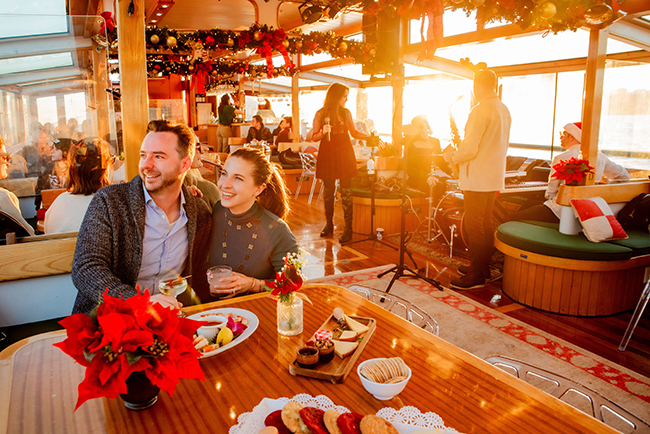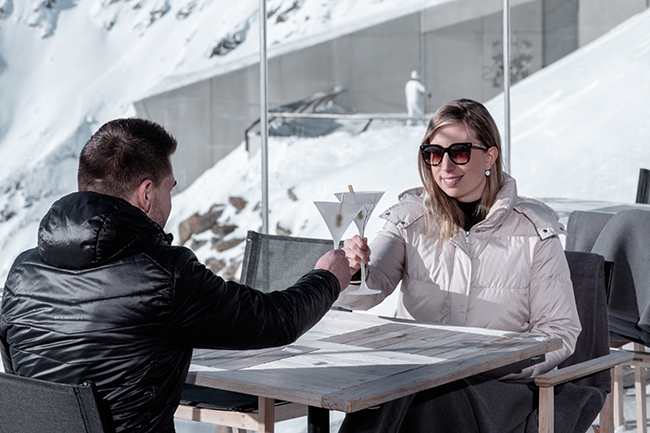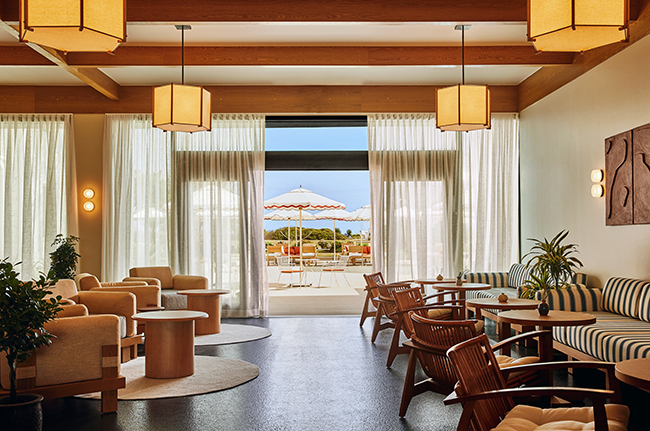Rapa Nui
07 Nov 2019
An archeological wonder
Text and photos by TERESA McLAMB
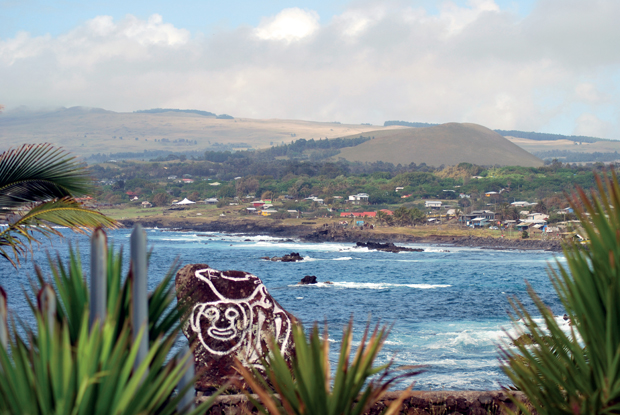
Five hours into our flight from Santiago, the animated airplane on the seat-back video halted its descent and banked to the right. Looking out the window, we saw thick clouds and an occasional ripple in the South Pacific Ocean below. Finally, the captain’s voice explained, “Rapa Nui is fogged in.” He has two hours of fuel available, so he’s going to circle a bit waiting for the weather to clear.
Rapa Nui is remote. At 2,300 miles from the coast of Chile (to which it belongs), its 63 square miles are a tiny speck in the ocean. Anthropologists believe the original settlers came by double hulled sailing craft from Polynesia. Carbon dating puts their arrival at 800 to 1000 AD where they likely settled into caves in the volcanic rock.
We landed easily in about 30 minutes, but it drove home the feeling of isolation the original settlers must have experienced. This may account for some of the island’s turbulent history including warfare and toppling of the famed statues.
Today’s inhabitants, about 3,000 or so, enjoy daily flights (landing on a 12,000 foot runway funded by the US government just in case the space shuttle needed to land there), deliveries from Amazon.com, wi-fi, four television stations, fabulous food from the sea, two gas stations and frequent freighters bringing food, cars and much more. Horses, cows and chickens roam freely, largely ignoring the occasional corrals.
A 2018 law requires all visitors to the island to prove accommodation reservations and a return flight. Rapa Nui has proven such a popular destination for people to run away to that the government has evicted hundreds thus far.
In its early days, Rapa Nui was forested with palms and native grasses. Today, while there are trees, much of the terrain is scrub grass. Exactly when and how it got that way is among the many mysteries here. The maoi and thousands of petroglyphs document its history.
Despite earlier theories, DNA has proven a genetic tie to Polynesia, according to guide and native Estafan Fuenzalida and numerous written accounts. His college study was in linguistics, particularly Polynesian languages. His thesis presented many similarities between the Rapa Nui language and others from Polynesia.
Rapa Nui is best known for the maoi, carved human-like statues with oversized heads whose Rapa Nui name means literally “the face of my ancestor.” Ranging from 12 to 71 feet, they were carved mostly from the volcanic rock of the Rano Ranuku crater quarry and erected about 1200 – 1600AD. “Earlier statues, made elsewhere on the island with different materials, were of poorer quality,” said Fuenzalida. Twelve-ton red scoria top knots were made in a different area. They now lie scattered across the island.
Some statues include carved arms and hands. A few have earring holes reflecting explorers’ descriptions of natives who stretched their ear lobes with large disks. The earrings were made of obsidian although the statues no longer hold them; large pieces of obsidian, believed to be earrings, have been found. The last thing to be carved is believed to have been the eye sockets which were covered with pieces of coral to make the statue come alive. Only one coral piece has been found; it is in a British museum, as are several maoi.
Anthropologists and natives have pieced together that the statues stood atop stone platforms (ahu) under which remains of natives were interred. The maoi are believed to be representations of important members of the community. Their spirits, through the maoi, protected and guided the villagers who lived under their watchful eye. Ahu are scattered across the island. Several are alongside the water and many are inland where the more fertile land existed. Only 14 have been restored. The largest holds 15 statues. The largest statue on the island, Te Tokanga, measures 71 feet and lies incomplete in the quarry. “All told, 887 statues are known to exist around the world, many in museums,” Fuenzalida said.
Oral tradition says that the maoi carvers bartered with villagers for their services. That same tradition holds that the completed carvings walked to the ahu, a convenience for the purchaser who was responsible for its move from the quarry. Today the hillside of the main quarry is littered with about 400 statues as if they stopped mid-trek.
“No one knows the truth,” Fuenzalida said. Anthropologists have tried several methods of recreating the movement, but all have failed. Their stories are told in the Museo Rapa Nui.
“While it is believed the 15 statues at Ahu Tongariki were toppled by a tsunami, evidence doesn’t support the same for the other felled maoi,” Fuenzalida said. Tribal war, brought about by deforestation and food scarcity, is the most commonly held opinion.
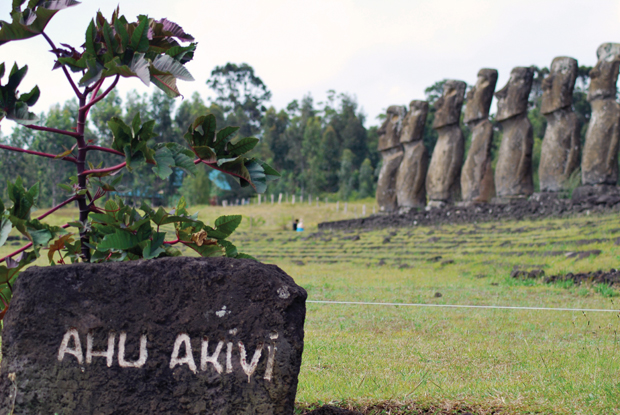
There are historical accounts, the first from Admiral Jacob Roggeveen, whose April 5, 1722 log includes descriptions of the upright maoi from afar and tales of nude natives who swam and canoed out to the ships. It also details a scuffle in which about 10 natives were shot to death. The journal entries of his Captain Burman tell a similar story, but several details are different. Overall, it appears the crews of the three ships did not explore the island. Their lasting gift, other than the loss of life, was to name it Easter Island (Isla de Pascua) for the day it was sighted.
Something cataclysmic happened between Roggeveen’s visit and that of Captain James Cook in 1774. Cook observed topped statues and a very small population versus the thousands estimated by Roggeveen.
Anthropologists believe carving stopped around 1650, and native attention shifted from the maoi to the Birdman Cult with its annual athletic contest to determine which family would rule the island. The last contest, according to missionaries who appeared in 1864, took place on October 17, 1867.
Alongside the ocean front village of Orongo is the crater of Rano Kau. The enormous mountain collapsed into itself about 2 ½ million years ago, its molten core spewing into the ocean.
Bird Man contestants were required to climb down the crater to the ocean, swim to Islet Motu Nui, about 1.5 miles away, and wait for the first nesting tern, Manu Tara, to lay an egg. They must then climb to the hillside nest, capture the egg and make it back home with the egg intact.
The winner spent the next year in relative isolation while his mandates were carried out through family members. The leader of the tribe was not allowed to work or to mix with others, so inbreeding was likely.
There was a different contest for women to select the king’s wife and possibly one for teenagers. “When you become an athlete, you don’t have to work. We’re trying to piece together the torn society,” Fuenzalida said.
By the time of the Birdman Cult, only seven of the original 15 tribes remained. The 1867 winner was later captured, along with 1,000 other natives, by Peruvian slave traders. “He died there, but several hundred were returned to the island,” Fuenzalida said, “bringing with them small pox. The isolation could have resulted in craziness. The universe is small. Polynesians on Rapa Nui knew there were other islands, but they couldn’t go back. Stories became myths. Many birds migrated, nested and left, and their leaving was thought to be the mythical and spiritual world.”
We’ll likely never know what happened on the island, but whatever it was left an intriguing mystery for natives, tourists and scientists. What is obvious is that a civilization of great scientific and mathematical abilities lived there. Perhaps the alien theorists are correct.
Want to go?
Daily flights from Santiago.
High season: December to March.
UV levels: High (11 on our arrival in November)
Lodging: 296 official places to stay from budget to luxury. We stayed in Hanga Roa Eco Lodge which includes a spa, guides, restaurants, free sun screen. Excellent food and service.
Surfing, hiking, SCUBA, horseback riding.
Excerpted from the 1722 Log of Admiral Jacob Roggeveen
April 7. During the forenoon Captain BOUMAN brought an Easter Islander on board, together with his craft, in which he had come off close to the Ship from the land; he was quite nude, without the slightest covering for that which modesty shrinks from revealing. This hapless creature seemed to be very glad to behold us, and showed the greatest wonder at the build of our Ship. He took special notice of the tautness of our spars, the stoutness of our rigging and running gear, the sails, the guns — which he felt all over with minute attention — and with everything else that he saw; especially when the image of his own features was displayed before him in a mirror, seeing the which, he started suddenly back and then looked towards the back of the glass, apparently in the expectation of discovering there the cause of the apparition.
After we had sufficiently beguiled ourselves with him, and he with us, we started him off again in his canoe towards the shore, having presented him with two strings of blue beads round his neck, a small mirror, a pair of scissors, and other like trifles, which seemed to have a special attraction for him.
April 9. A great many canoes came off to the ships: these people showed us at that time their great cupidity for every thing they saw; and were so daring that they took the seamen's hats and caps from off their heads, and sprang overboard with the spoil; for they are surpassingly good swimmers, as would seem from the great numbers of them who came swimming off from the shore to the ships. There was also an Easter Islander who climbed in through the cabin window of The African Galley, from his canoe, and seeing on the table, a cloth with which it was covered, and deeming it to be a good prize, he made his escape with it there and then; so that one must take special heed to keep close watch over everything.
Excerpted from 1722 log of Capt. Bouman who captained one of Roggeveen’s three ships
The people had, to judge by appearances, no weapons; although, as I remarked, they relied in case of need on their gods or idols which stand erected all along the sea shore in great numbers, before which they fall down and invoke them. These idols were all hewn out of stone, and in the form of a man, with long ears, adorned on the head with a crown, yet all made with skill: whereat we wondered not a little.




